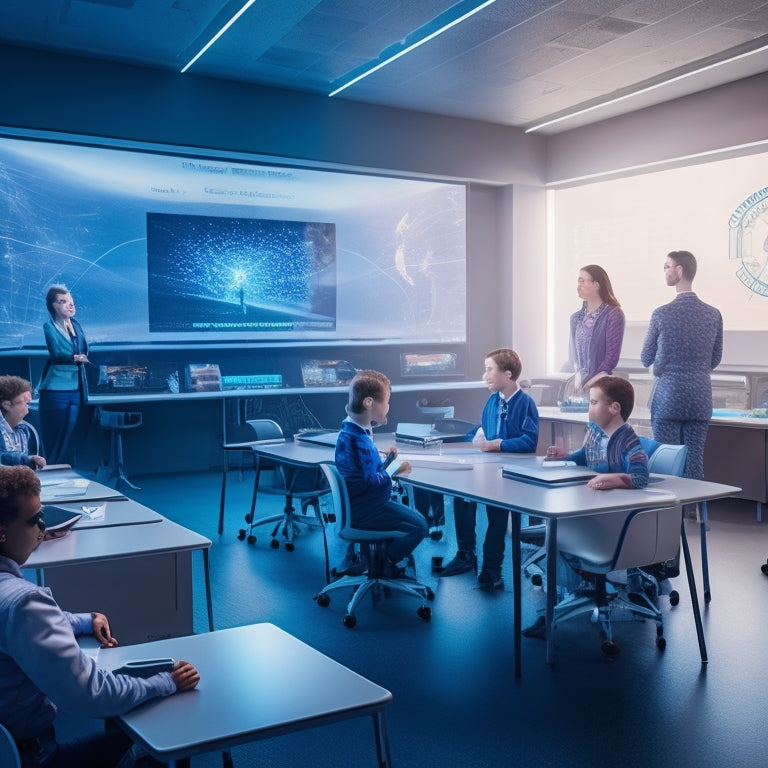
Cutting-Edge Tech Revolutionizes Educational Landscape
Share
Cutting-edge technologies are fundamentally transforming the educational landscape, empowering teachers, and redefining the way students learn and interact with complex concepts. Virtual classrooms, augmented reality, and personalized learning experiences are creating immersive and engaging environments that improve knowledge retention and student motivation. Emerging technologies like AI, blockchain, and IoT are reshaping education, preparing students for future readiness in a digital world. As technology continues to integrate into education, it's becoming clear that the future of learning is one of limitless possibilities, and the journey is only just beginning.
Key Takeaways
• Emerging technologies like AI, blockchain, and IoT are transforming the education sector with immersive and interactive learning experiences.
• Virtual and augmented reality technologies create engaging environments that enhance knowledge retention and student motivation.
• Technology integration enables personalized learning experiences tailored to individual students' needs, improving academic achievement and satisfaction.
• Data-driven insights from vast amounts of educational data optimize instructional strategies, leading to better academic outcomes and more effective learning environments.
• Educators empowered with technology can focus on providing support, streamlining workflow, and collaborating with peers to achieve enhanced student outcomes.
Revolutionizing the Classroom Experience
The integration of educational technology into the classroom experience has transformed the traditional learning environment, enabling educators to craft engaging, interactive, and personalized lessons that cater to diverse learning styles.
Virtual classrooms have become a reality, allowing for interactive engagement and remote participation.
Augmented reality has taken hands-on learning to the next level, enabling students to explore complex concepts in an immersive and interactive manner.
This shift has enabled educators to create a more inclusive and effective learning environment, where students can engage with course material in a way that suits their individual needs.
As a result, students are more motivated, and knowledge retention has improved significantly.
Trends Shaping the Future
Emerging technologies are rewriting the script of education, as innovations like artificial intelligence, blockchain, and the Internet of Things (IoT) converge to reshape the future of learning.
These trends are driving technology integration, preparing students for future readiness in an increasingly digital world.
As education evolves, it's vital to stay ahead of the curve, embracing advancements that enhance the learning experience.
By harnessing the power of AI, blockchain, and IoT, educators can create personalized, immersive, and interactive environments that foster engagement and motivation.
As the landscape continues to shift, it's important to prioritize technology integration, ensuring students are equipped with the skills and knowledge necessary to thrive in an ever-changing world.
Personalized Learning Experiences
Sixty-seven percent of educators believe that personalized learning experiences are essential for student success, and technology is poised to play a pivotal role in making this vision a reality.
Adaptive learning systems, powered by artificial intelligence, can analyze individual students' strengths, weaknesses, and learning patterns to provide individualized instruction tailored to their unique needs. This results in more effective learning outcomes, as students engage with content that resonates with them.
Moreover, technology enables teachers to track student progress in real-time, identifying areas where students require additional support or enrichment. By leveraging technology, educators can create a more inclusive and effective learning environment that caters to diverse learning styles, ultimately leading to improved academic achievement and increased student satisfaction.
Empowering Educators With Technology
By harnessing the power of technology, educators can streamline their workflow, freeing up time to focus on what matters most: providing high-quality instruction and personalized support to their students.
Digital empowerment enables teachers to efficiently manage administrative tasks, grade assignments, and track student progress. Tech integration also facilitates seamless collaboration with colleagues, allowing for shared resources and expertise.
Moreover, educators can leverage technology to create customized lesson plans, cater to diverse learning styles, and provide real-time feedback. As a result, teachers can optimize their instructional approach, leading to improved student outcomes and enhanced academic performance.
Immersive Learning Environments
Virtual and augmented reality technologies are redefining the educational landscape by creating immersive learning environments that simulate real-world experiences, making complex concepts more engaging, interactive, and accessible to students.
These virtual simulations enable interactive engagement, allowing students to explore and experiment with complex concepts in a safe and controlled environment. Immersive technology facilitates experiential learning, enabling students to develop a deeper understanding of abstract concepts by directly experiencing them.
This approach enhances knowledge retention, as students are more likely to remember experiences rather than mere lectures. By leveraging immersive technology, educators can create engaging, interactive, and effective learning experiences that prepare students for real-world challenges.
Data-Driven Educational Insights
With the ability to capture and analyze vast amounts of data, educational institutions can now uncover valuable insights into student learning patterns, identifying areas of improvement and optimizing instructional strategies to drive better academic outcomes.
Data visualization tools provide a clear and concise representation of student performance, enabling educators to pinpoint strengths and weaknesses. This information can be leveraged to create personalized instruction, tailoring the learning experience to meet the unique needs of each student.
Predictive analytics takes this a step further, allowing educators to forecast student performance and proactively address potential issues. By harnessing the power of data-driven insights, educators can create a more effective and efficient learning environment, ultimately leading to improved academic outcomes.
Transforming the Learning Journey
As technology continues to reshape the educational landscape, it is revolutionizing the way students learn, creating a more dynamic and immersive experience that caters to diverse learning styles and preferences. Virtual simulations and interactive assessments are redefining the way students engage with complex concepts, making learning more engaging and effective.
Adaptive learning and competency-based education are also transforming the learning journey, allowing students to progress at their own pace and focus on mastering specific skills. This personalized approach enables students to take ownership of their learning, fostering a deeper understanding of the subject matter and preparing them for success in the digital age.
Frequently Asked Questions
How Do Ed-Tech Companies Ensure Data Privacy and Security for Students?
Ed-tech companies must prioritize data privacy and security for students by implementing robust safeguards against cyber risks, adhering to digital ethics, and ensuring transparent data management practices to protect sensitive information and maintain trust.
Can Artificial Intelligence Replace Human Teachers in the Classroom?
While AI can augment teaching styles, it is unlikely to fully replace human teachers, as it lacks emotional intelligence and human connection, which are essential for best learning outcomes, student motivation, and social development.
What Are the Costs Associated With Implementing Ed-Tech in Schools?
As schools begin the digital journey, they must navigate the 'valley of darkness' of implementation challenges and budget constraints, where the costs of ed-tech integration can be a significant obstacle to realizing its transformative potential.
How Does Ed-Tech Cater to Students With Disabilities and Special Needs?
Ed-tech caters to students with disabilities and special needs through Accessibility Tools, enabling personalized learning experiences tailored to individual requirements, fostering inclusivity, and promoting equal access to education.
Can Online Learning Platforms Replicate the Social Benefits of Traditional Schools?
As online learning platforms proliferate, a pressing concern emerges: can they replicate the social benefits of traditional schools? While virtual friendships and digital etiquette are possible, they lack the depth and nuance of in-person interactions, leaving a lingering sense of isolation.
Related Posts
-

Emergency Sanitation Essentials for Your Needs
In emergency situations, access to proper sanitation facilities is essential for maintaining personal hygiene, preven...
-

Transformative Techniques and Innovations in Mud Building
You're about to discover the cutting-edge of mud building, where ancient techniques meet modern innovations. Revoluti...

